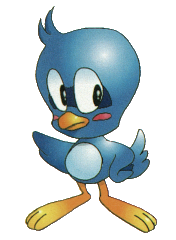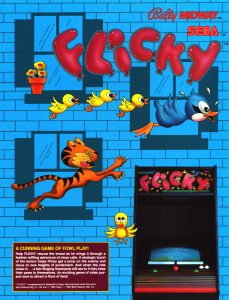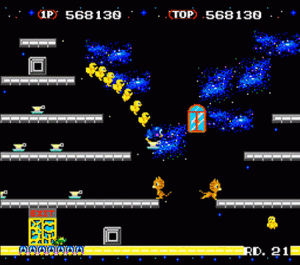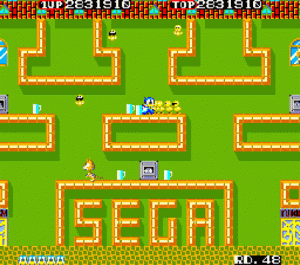 By the late 1970s, games like Space Invaders had helped to make arcades a rapidly expanding pop culture phenomenon. In the ‘80s, further arcade hits, like the immortal Pac-Man, only added fuel to the arcade fire sweeping the nation. Arcades were everywhere, and game manufacturers were raking in millions of dollars each year. It was early during this time that Sega began to hit its full stride in the arcades: licensed games like Frogger and their own original properties like Zaxxon both brought massive success. However, senior leadership at Sega knew it needed something more. In order for the Sega brand to truly shine, it needed an original character to call its own. Sega needed a mascot.
By the late 1970s, games like Space Invaders had helped to make arcades a rapidly expanding pop culture phenomenon. In the ‘80s, further arcade hits, like the immortal Pac-Man, only added fuel to the arcade fire sweeping the nation. Arcades were everywhere, and game manufacturers were raking in millions of dollars each year. It was early during this time that Sega began to hit its full stride in the arcades: licensed games like Frogger and their own original properties like Zaxxon both brought massive success. However, senior leadership at Sega knew it needed something more. In order for the Sega brand to truly shine, it needed an original character to call its own. Sega needed a mascot.
If Namco had Pac-Man, then Sega needed its own brand ambassador. And so, in 1984, Sega released an arcade game featuring a blue-toned sprite poised to become the face of its brand. It wasn’t an anthropomorphic hedgehog – no, years before the iconic Sonic The Hedgehog sped into millions of homes, Flicky, a blue mother bird, flew into arcades.
The First Face of Sega
Coming off the success of hits like Zaxxon and Super Zaxxon, Sega management wanted to ride the momentum and continue to lead the arcade gaming industry in innovation. Rival game manufacturer Namco had just released Mappy, a side scrolling platformer that featured a cute, anthropomorphic mouse as its titular character. Mappy proved successful for Namco, even being listed as Japan’s third most successful arcade game of 1983 by Game Machine.
Deciding its needed its own platforming adventure featuring an adorable character, the task of launching Sega’s response to Mappy fell to Yoji Ishii. Having joined the company in 1978, Flicky was one of Ishii’s first projects at Sega. Ishii worked closely with Sega artist Yoshiki Kawasaki, who had joined Sega a few years earlier in 1976.
Together, Ishii and Kawasaki would create an enduring platformer and character that would become ingrained within Sega’s early arcade legacy and, eventually, into the Sonic The Hedgehog’s mythos.
Kawasaki’s Inspiration Takes Flight
Initially intended as a simple “dot eater” maze-style game, Kawasaki took inspiration from “Migoro! Tabegoro! Waraigoro!”, a Japanese television show that was popular during the ‘70s. In the show, there was a catchy, lighthearted tune about sparrows. Its lyrics playfully chirped along to the sparrows’ particular penchant for perching across power lines. This song, and subsequently the bird which it placed front and center, would continue to stick with Kawasaki. If Namco had Mappy the mouse, then Kawasaki decided Sega would have a sparrow – albeit a blue one, much to the subsequent confusion of gamers.
Although Flicky started out as little more than a simple dot eater game featuring a bird skittering across power lines, it would quickly evolve into much more. Despite having limited resources at his disposal, Kawasaki felt restless with the game’s initial design. So, he decided to experiment. Power lines, he determined, weren’t fun or visually appealing for gamers. As he stared out of his office window, he struck upon the idea of changing the background of the game from simple power lines set against a solid color background, to the multi-colored side of an apartment building. Soon, other changes would follow that would help to make Flicky a stand-out original title for Sega.
Small Innovations & Charming Gameplay
After progressing further into development, Kawasaki realized he had extra memory available. In turn, he started to play with a few of the game’s other graphics and features. An artist by nature, he began by increasing the size of the small yellow dots placed around the map. Then, realizing they were large enough, he gave them the basic features of a chick. These chicks would become the game’s “Chirps,” Flicky’s flock of scattered peeps she was challenged to recover.
Next, the team decided to increase the game’s difficulty by programming the Chirps to follow Flicky in an increasingly large line as she collected them. Now, players not only had to collect each Chirp on the map but also maneuver around enemies and safely return the ever-expanding line of Chirps to a specific point on the level. If an enemy did successfully intercept the Chirps, they would break off from Flicky but still had to be recovered before players could move to the next stage. To reward skillful players, the more Chirps that were returned at once, the larger the score. Thus, players were encouraged to bring back as many Chirps in a single trip as possible.
Lastly, Kawasaki created the “bad” Chirp. These sunglass-wearing chicks were characteristically rebellious. Their programming made them extra difficult to recover, as they would flee at random if touched by an enemy. After Kawasaki’s changes, what had started as a simple game based on a basic premise had become a charming platforming that, for many gamers, has stood the test of time.
Flicky Enters the Arcades
Flicky was built on Sega’s System 1 series of arcade boards. The System 1 platform debuted in 1983 and was used in the development of other Sega arcade games like Regulus, Sega Ninja, and Teddy Boy Blues. However, despite its popularity and use by other developers, the System 1 board was quickly replaced with the System 2 platform in 1985.
The arcade cabinet housing Flicky was standard fare for its time. The game was only available in one configuration: a simple upright cabinet with a horizontally positioned raster monitor. Aside from a marquee with “Flicky” spelled out in pink, balloon-like letters, the game’s cabinet art was unfortunately unremarkable. Today, it’s a relatively common cabinet among games of its era. Despite a lack of rarity, it’s still a welcome addition to many arcade enthusiasts’ or Sega fans’ collections.
The Legacy of Flicky
 Soon after its arcade release, Flicky received a port to Sega’s SG-1000 console. In subsequent years, it saw ports to the Sega Master System, Sega Genesis, various computer ports in the ‘80s, and two mobile ports in the early 2000s. It has also been featured in several compilations.
Soon after its arcade release, Flicky received a port to Sega’s SG-1000 console. In subsequent years, it saw ports to the Sega Master System, Sega Genesis, various computer ports in the ‘80s, and two mobile ports in the early 2000s. It has also been featured in several compilations.
The game was generally received well, with the arcade cabinet launching as a moderate success for Sega. By the time Flicky reached the Sega Genesis, its graphics had not stood the test of time; however, gamers still found Flicky’s simple yet challenging gameplay to stand-up to contemporary games.
Flicky has continued to live on in small ways. Perhaps her most endearing legacy is lending her likeness and name to a species of birds native to the Sonic The Hedgehog universe. In total, “flickies” have since made appearances in two dozen Sonic games, even inhabiting their very own island, Flicky Island, in Sonic 3D Blast.
Despite its initial success, Flicky didn’t have the impact Sega executives had hoped. The character Flicky herself never truly caught on. It wouldn’t be for several more years until Sega would finally have the mascot they were searching for. While she wasn’t Sega’s most famous blue mascot, Flicky was certainly their first.
About the Author: Gene Goodman is vice president of M&P Amusement, a distributor of new and quality refurbished used arcade games and pinball machines in operation since 1932 and headquartered in York, Pennsylvania.



Recent Comments